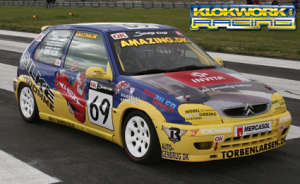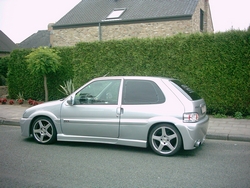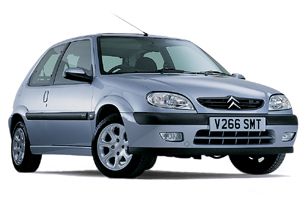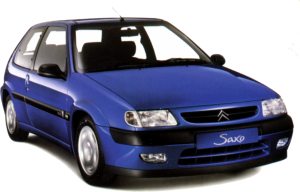




The Citroën Saxo was a supermini produced by the French manufacturer Citroën from 1996 to 2003.
The Saxo, known during its development phase as "Project S8", was launched in 1996 to replace the aging Citroën AX. Much of the Saxo's engineering was shared with the Peugeot 106 of Citroën's parent company, Peugeot.
The Saxo was one of several Citroëns from the 1990s criticised for looking too conservative and ordinary, in contrast to the avant-garde design of earlier Citroëns like the CX, BX and XM. In particular, the Saxo shared not only mechanical pieces but also its body design and appearance with the Peugeot 106, much as ancestor Citroën LNA was a badge engineered version of the Peugeot 104.
A multitude of different trim levels came and went during the Saxo's lifetime, although each different named trim level, such as the Saxo First, Saxo Desire, Saxo Executive, and Saxo Furio, used one of three engines; 1.1 L and 1.4 L petrol engines and a 1.5 L naturally-aspirated diesel engine. Two high performance models called the Saxo VTR (using a 1.6 L 8-valve engine, initially producing 90 bhp and 98 bhp in later models) and the Saxo VTS (using a 1.6 L 16-valve engine producing 120 bhp) were launched in 1997. The Saxo in general, and these high performance models in particular, were very popular with young drivers.
In late 1997, the Saxo received a "facelift" in the form of a new front grille. This became known as the "smiley" grille due to its similarity to a smiling mouth. Around this time, Citroën also started fitting transponder chip immobilisers, rather than the keypad type immobilisers of previous models.
In 1999, the 'Mk II' or Phase II version of the Saxo was introduced, featuring an updated front end, notably the headlights. The rear of the car received only a minor styling change in that the light cluster colouration was slightly lighter than its predecessor.
By the beginning of 2002, the end was in sight for the Saxo with its design now more than a decade old. The more spacious and practical five-door C3 attracted buyers, and Saxo sales fell dramatically. Only the VTR and VTS models remained popular. The Saxo finally finished production in late 2003 when the three-door C2 was launched. Its twin, the Peugeot 106, also ceased production at this time.
The Saxo, known during its development phase as "Project S8", was launched in 1996 to replace the aging Citroën AX. Much of the Saxo's engineering was shared with the Peugeot 106 of Citroën's parent company, Peugeot.
The Saxo was one of several Citroëns from the 1990s criticised for looking too conservative and ordinary, in contrast to the avant-garde design of earlier Citroëns like the CX, BX and XM. In particular, the Saxo shared not only mechanical pieces but also its body design and appearance with the Peugeot 106, much as ancestor Citroën LNA was a badge engineered version of the Peugeot 104.
A multitude of different trim levels came and went during the Saxo's lifetime, although each different named trim level, such as the Saxo First, Saxo Desire, Saxo Executive, and Saxo Furio, used one of three engines; 1.1 L and 1.4 L petrol engines and a 1.5 L naturally-aspirated diesel engine. Two high performance models called the Saxo VTR (using a 1.6 L 8-valve engine, initially producing 90 bhp and 98 bhp in later models) and the Saxo VTS (using a 1.6 L 16-valve engine producing 120 bhp) were launched in 1997. The Saxo in general, and these high performance models in particular, were very popular with young drivers.
In late 1997, the Saxo received a "facelift" in the form of a new front grille. This became known as the "smiley" grille due to its similarity to a smiling mouth. Around this time, Citroën also started fitting transponder chip immobilisers, rather than the keypad type immobilisers of previous models.
In 1999, the 'Mk II' or Phase II version of the Saxo was introduced, featuring an updated front end, notably the headlights. The rear of the car received only a minor styling change in that the light cluster colouration was slightly lighter than its predecessor.
By the beginning of 2002, the end was in sight for the Saxo with its design now more than a decade old. The more spacious and practical five-door C3 attracted buyers, and Saxo sales fell dramatically. Only the VTR and VTS models remained popular. The Saxo finally finished production in late 2003 when the three-door C2 was launched. Its twin, the Peugeot 106, also ceased production at this time.
No comments:
Post a Comment